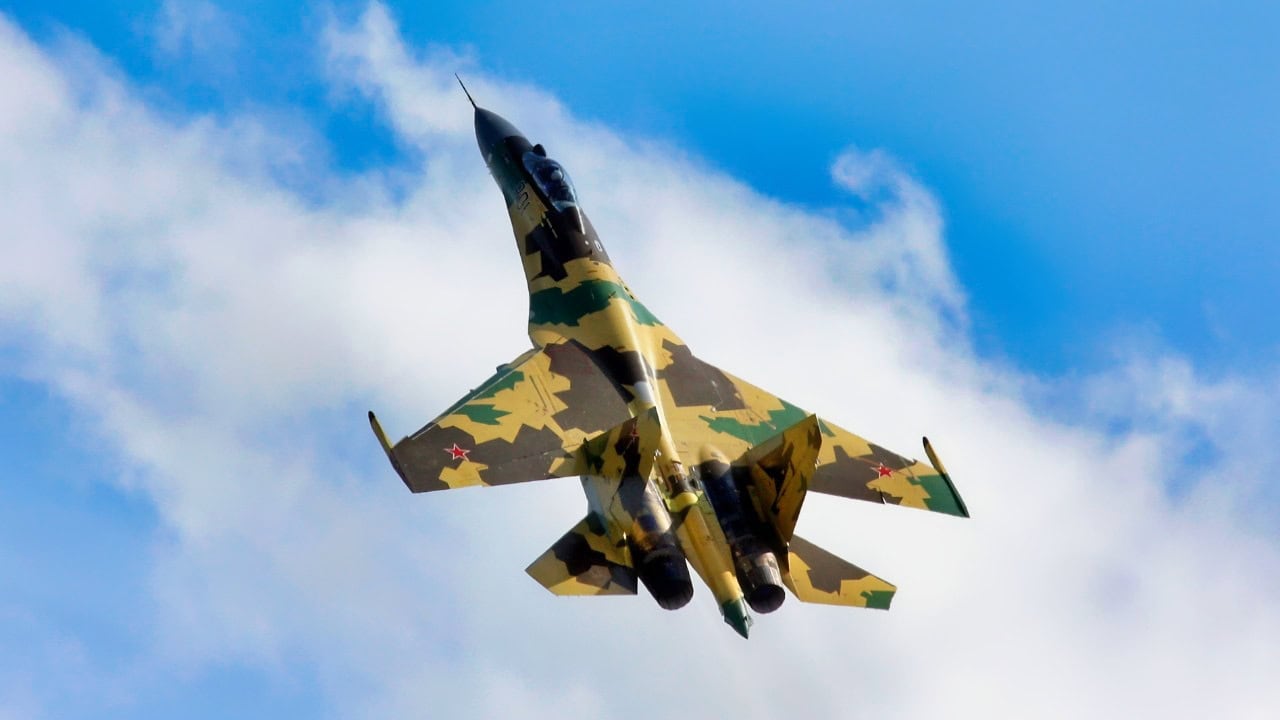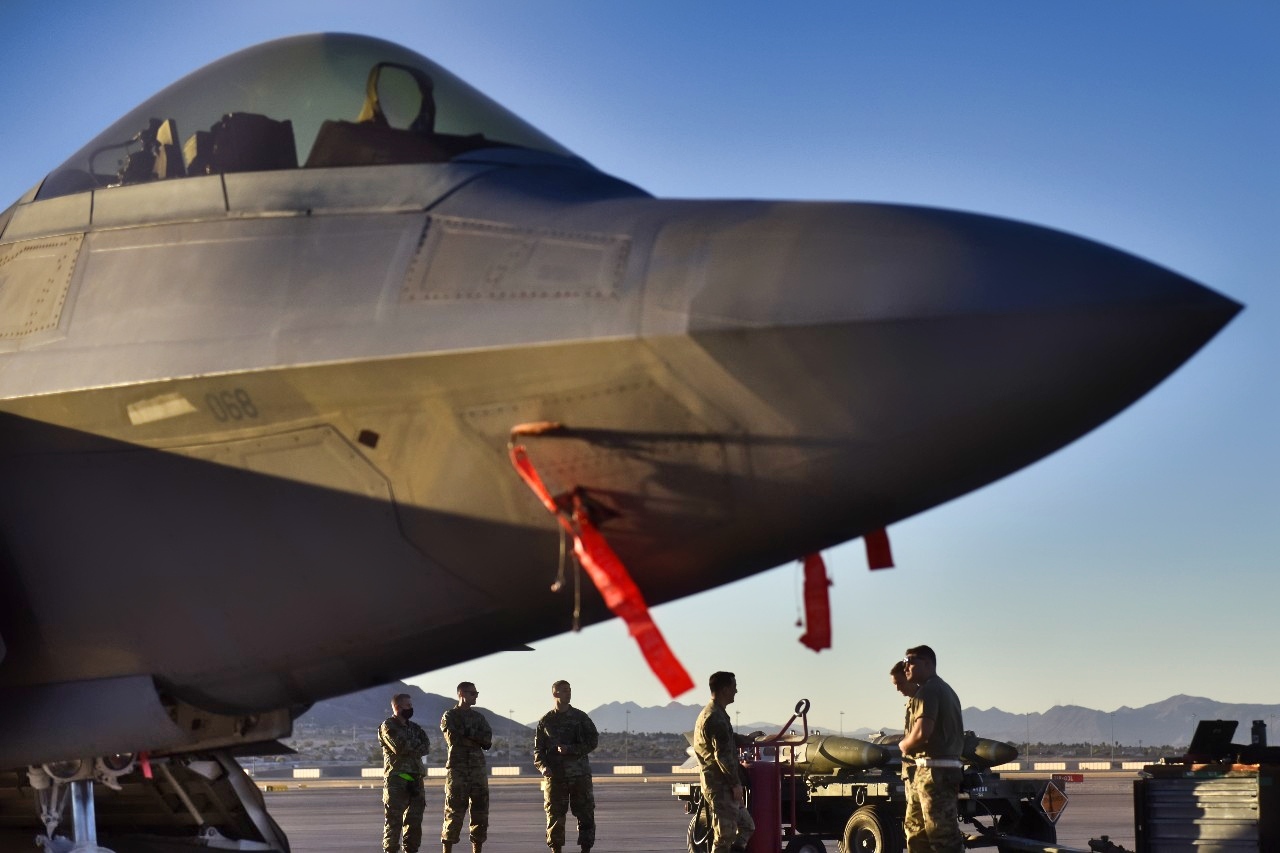The Su-35S Flanker-E: Russia’s Apex Predator of the 4th Generation
The Sukhoi Su-35S, designated “Flanker-E” by NATO, represents the zenith of conventional 4th-generation fighter design and a cornerstone of the modern Russian Aerospace Forces (VKS).
Su-35. Image Credit: Creative Commons.
It is not merely an incremental upgrade of its legendary progenitor, the Su-27, but a comprehensive “deep modernization” that resulted in a profoundly more capable multi-role combat aircraft.
The Su-35S is a strategic asset born from the crucible of post-Soviet economic realities and the protracted development of Russia’s 5th-generation Su-57 program, for which it serves as a critical technological and operational bridge.
The aircraft is defined by a triad of core capabilities: extreme “supermaneuverability” endowed by powerful thrust-vectoring engines, a suite of advanced long-range sensors, and a formidable multi-role weapons payload that allows it to contest air superiority and execute precision strikes.
The Su-35S serves as a crucial stopgap for the VKS, furnishing a high-end capability to counter advanced Western 4th-generation fighters while the more complex and costly Su-57 program matures and scales.
Its combat deployments in Syria and, more significantly, Ukraine have provided the VKS with invaluable operational experience, serving as both a live-fire testing ground for tactics and technology and a high-stakes marketing showcase for potential export customers.
This report provides an exhaustive analysis of the Su-35S, examining its developmental lineage, technical specifications, comparative performance, combat history, and its strategic role in Russian military doctrine and foreign policy.
A Flanker Forged Anew: From Su-27M to Su-35S
The evolutionary path from the original Su-27 to the modern Su-35S is not a simple, linear upgrade but a complex story of ambition, collapse, and pragmatic resurrection.
It encompasses two distinct design phases separated by the dissolution of the Soviet Union, with the final Su-35S benefiting from technologies refined in parallel programs that were never intended for it.
The Soviet Precursor (Su-27M)
The genesis of an advanced Flanker began in the early 1980s, culminating in the Su-27M program, which first took to the skies on June 28, 1988.
This aircraft represented a significant leap beyond the baseline Su-27’s pure air superiority mission, aiming for a true multi-role capability. Key features included the addition of canard foreplanes for enhanced maneuverability and stability, a new N011 multi-mode radar with ground-mapping capabilities, a modernized glass cockpit with CRT displays, and an in-flight refueling probe to extend its operational reach.
In a bid to capture international interest and funding, the Sukhoi Design Bureau marketed this advanced variant as the “Su-35“.
However, within the Soviet military, its official designation remained Su-27M. Despite its promising capabilities, the program fell victim to the economic chaos and political disintegration of the Soviet Union. Mass production was never initiated, and the program was effectively terminated after only a small number of prototypes and demonstrators—sources suggest between 12 and 14—were constructed.
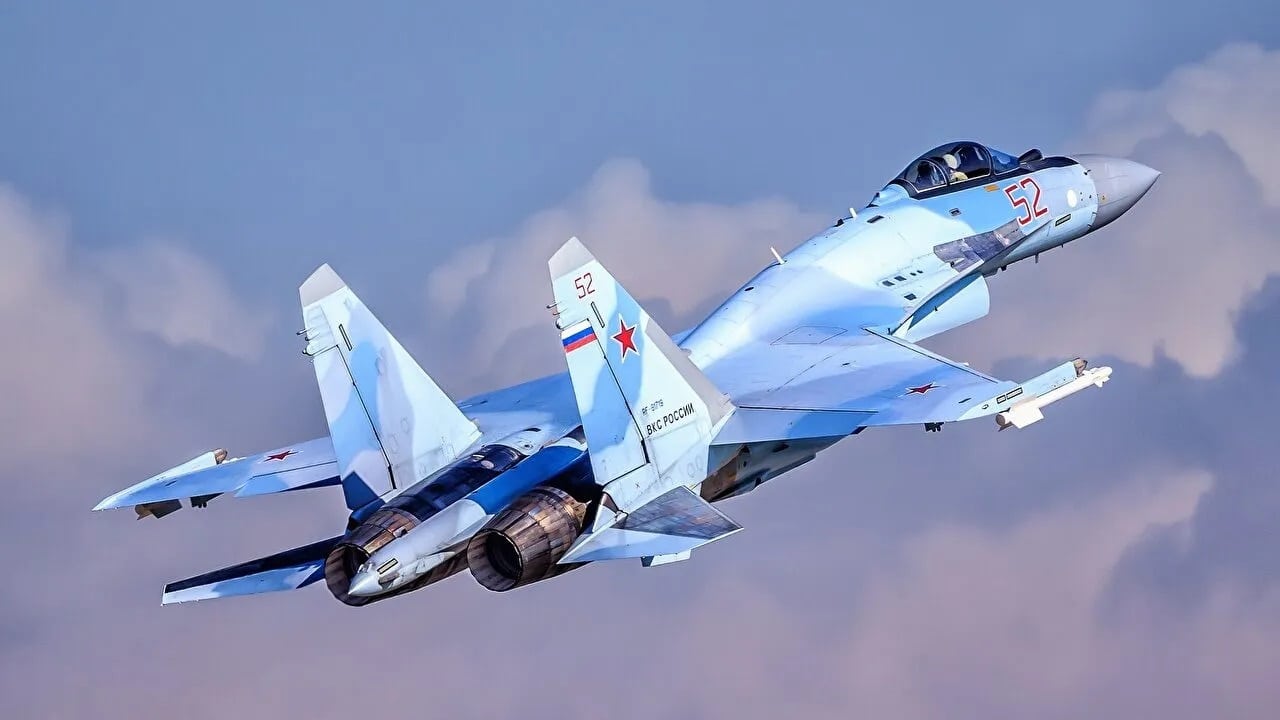
Russian Air Force Su-35. Image Credit: Creative Commons.
One of these airframes, T10M-11, was later fitted with experimental thrust-vectoring engines and redesignated the Su-37 “Terminator,” serving as a crucial technology demonstrator that would heavily influence future Flanker developments.
The “Deep Modernization” (Su-35BM/Su-35S)
The Su-27M’s failure to enter production created a significant capability gap for the newly formed Russian Air Force. As the 1990s progressed, it became clear that Russia’s fifth-generation fighter programs, the MiG 1.44 and Su-47, were stalled, and the subsequent PAK FA program (which would eventually produce the Su-57) faced a long and uncertain development timeline.
In 2003, Sukhoi launched a new, privately funded initiative to create a heavily upgraded Flanker that could serve as a powerful interim solution. This project was designated Su-35BM, meaning Bolshaya Modernizatsiya, or “Big Modernization.”
This was not a simple revival of the Su-27M. Instead, it was a more radical redesign that leveraged nearly two decades of technological progress. It integrated key technologies that had been matured on the successful Su-30MKI export program for India, such as advanced avionics and thrust-vectoring, while also incorporating systems being developed for the nascent Su-57.
The first Su-35BM prototype performed its maiden flight on February 19, 2008. The Russian Aerospace Forces became the launch customer, placing their first order in 2009, with the production version designated Su-35S (Stroyevoy, or “Combatant”). The aircraft officially entered service in February 2014.
The evolution of the Su-35S is a clear illustration of pragmatic adaptation in the face of geopolitical and economic upheaval. The Su-27M represented the Soviet Union’s peak ambition for a fourth-generation multi-role fighter, an ambition that was cut short by the state’s collapse.
This left the Russian Air Force with a looming capability gap as Western air forces continued to advance. The Su-30MKI, developed for a foreign customer, became an unexpected technological lifeline, allowing Sukhoi to refine and prove key systems like digital flight controls and thrust vectoring that were too costly to pursue domestically at the time.
The Su-35S program then masterfully re-integrated these matured technologies, along with advanced sensor and engine elements from the Su-57 program, back into the proven Flanker airframe.11 The Su-35S is therefore not just an “upgraded Su-27”; it is the beneficiary of two decades of parallel, and at times divergent, development paths, resurrected to fill a strategic void left by both the Soviet collapse and the slow pace of Russia’s fifth-generation ambitions. It is a powerful, pragmatic solution born directly from necessity.
Anatomy of a Super Flanker: A Technical Deep Dive
The Su-35S is a fundamentally different machine from its predecessors, featuring extensive modifications to its airframe, a new generation of powerplants, and a completely overhauled sensor and avionics architecture. These changes collectively produce an aircraft with a flight envelope and combat capability far exceeding any previous Flanker variant.
Airframe and Aerodynamics
The Su-35S airframe, while retaining the iconic Flanker silhouette, underwent a significant redesign to enhance performance, increase service life, and reduce its radar signature.
The structure was reinforced, with extensive use of titanium alloys and an increased share of composite materials, which extended its service life to 6,000 flight hours or 30 years of operation.
A key aerodynamic and visual distinction is the removal of the canard foreplanes that were a defining feature of the Su-27M and Su-30MKI.

Su-35 fighter. Image Credit: Creative Commons.
The large dorsal airbrake found on the Su-27 was also eliminated. Braking functions are now performed by the differential deflection of the twin rudders.
This cleaner aerodynamic configuration was made possible by two key advancements. First, the development of a more sophisticated quadruple-redundant digital fly-by-wire (FBW) system, the KSU-35, provided the necessary stability and control authority without the need for canards. Second, the introduction of powerful thrust-vectoring engines allowed for a shift in the aircraft’s center of gravity and provided exceptional control, rendering the canards redundant.
Engineers also took steps to reduce the aircraft’s radar cross-section (RCS). While not a stealth aircraft, the Su-35S incorporates radar-absorbent materials (RAM) in critical areas like the engine inlets and the leading edges of the wings. These measures, combined with a smoother airframe, are reported to reduce its frontal RCS to between 1 and 3 square meters, a significant reduction compared to the Su-27.
To enhance its range and endurance, the internal fuel capacity was increased by over 20% to 11,500 kg.
Furthermore, the Su-35S became the first single-seat Flanker variant designed from the outset to be compatible with external fuel tanks, capable of carrying two 2,000-liter drop tanks.
Propulsion and Supermaneuverability
The heart of the Su-35S’s performance is its pair of Saturn AL-41F1S (Izdeliye 117S) afterburning turbofan engines.
These are not entirely new powerplants but are heavily upgraded derivatives of the venerable AL-31F engine family. They share a common core with the first-stage AL-41F1 engine developed for the Su-57 stealth fighter, differing primarily in the engine control system.
Each engine can produce up to 86.3 kN of dry thrust and a formidable 142.2 kN (approximately 32,000 lbf) with afterburner in an emergency power setting.
This gives the aircraft a thrust-to-weight ratio greater than 1:1 at normal combat weight, enabling exceptional acceleration and a rate of climb exceeding 280 m/s (55,000 ft/min).
The engines’ most defining feature is their three-dimensional thrust-vectoring control (TVC) nozzles. These nozzles can deflect independently in both pitch and yaw, granting the Su-35S its signature “supermaneuverability”.
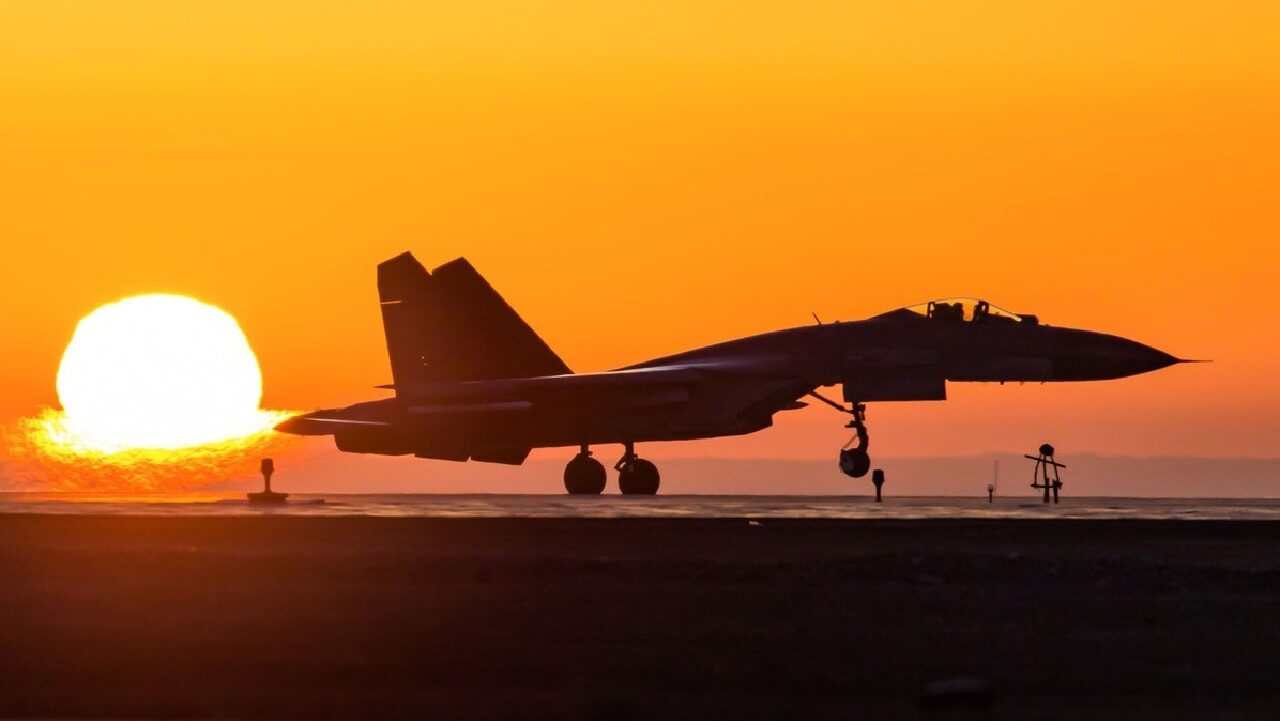
Su-35. Image Credit: Creative Commons.
This capability allows the aircraft to perform extreme post-stall maneuvers at very low airspeeds—such as the Pugachev’s Cobra, the Kulbit (somersault), and the flat spin—that are impossible for conventional fighters. While their direct combat utility is debated, these maneuvers can be used to change the aircraft’s pointing direction rapidly or to break an opponent’s radar lock.
Furthermore, the power and efficiency of the AL-41F1S engines enable the Su-35S to achieve a limited supercruise capability. This allows the aircraft to sustain supersonic flight at speeds of Mach 1.1 or higher, without the significant fuel consumption associated with afterburners, providing a substantial tactical advantage. This advantage increases engagement range and reduces reaction time for both offensive and defensive maneuvers.
The Digital Hunter: Avionics and Sensor Suite
The Su-35S is equipped with a completely new sensor and avionics suite that represents a generational leap over the Su-27.
- Irbis-E Radar: The primary sensor is the N035 Irbis-E (“Snow Leopard”), a powerful X-band Passive Electronically Scanned Array (PESA) radar developed by the Tikhomirov NIIP institute. Its 900mm antenna is mounted on a two-step electro-hydraulic drive. This hybrid system combines the rapid beam steering of electronic scanning (±60°) with mechanical movement of the entire array (another ±60°), giving it an exceptionally wide total field of regard of ±120° in azimuth. The radar is extremely powerful, with a peak output of 20 kW. This allows it to detect a fighter-sized target (3m² RCS) at ranges up to 400 km in a narrow search sector. It can track up to 30 airborne targets and simultaneously engage up to eight. It also possesses advanced air-to-surface modes, including high-resolution Synthetic Aperture Radar (SAR) mapping.
- OLS-35 IRST: Complementing the radar is the OLS-35, an advanced Infrared Search and Track (IRST) system housed in the traditional Flanker position forward of the cockpit, offset to the starboard side. This system provides passive (non-emitting) detection and tracking of aerial targets, a critical capability for operating in a radar-silent mode or against stealth aircraft. It has a claimed detection range against a non-afterburning fighter of up to 90 km from the rear hemisphere and 50 km from the front. The OLS-35 also integrates a television camera and a laser rangefinder/target designator for both air and ground targets.
- Defensive Systems: The aircraft’s survivability is enhanced by the integrated L175M Khibiny-M electronic countermeasures (ECM) suite. This system includes a sophisticated radar warning receiver (RWR), digital radio frequency memory (DRFM) jammers, and flare/chaff dispensers to defeat and deceive enemy radar and missile threats.
The avionics architecture of the Su-35S reveals a distinct Russian design philosophy that contrasts sharply with its Western contemporaries. While fighters like the F-15EX and F-35 prioritize Active Electronically Scanned Array (AESA) radars and highly integrated sensor fusion for low-probability-of-intercept (LPI) operations and networked data sharing, the Su-35S employs a more direct, power-focused approach. The Irbis-E PESA radar is designed to be overwhelmingly powerful, capable of “burning through” enemy electronic jamming and detecting targets at extreme ranges. This is paired with the long-range passive detection of the OLS-35 IRST.

Image: Creative Commons.
This combination reflects a doctrine that values raw detection power and a mix of active and passive sensing over the networked stealth and data-centric warfare that are central to Western 5th-generation concepts. It represents a “brute force” method of achieving situational awareness, aiming to overwhelm an opponent’s countermeasures rather than to remain entirely undetected.
Claws of the Flanker: Armament and Mission Capabilities
The Su-35S’s transition to a true multi-role platform is most evident in its vast and modernized arsenal. With 12 external hardpoints and a maximum payload of 8,000 kg, it can be configured for a wide spectrum of missions, from air superiority to standoff strikes.
Air-to-Air Dominance
In the air-to-air role, the Su-35S leverages a layered missile capability to engage targets from beyond visual range to close-in dogfights.
- Very Long-Range: The aircraft’s most formidable air-to-air weapon is the R-37M (NATO: AA-13 ‘Axehead’). This massive missile, originally developed for the MiG-31 interceptor, has a reported range approaching 400 km and a hypersonic speed of Mach 6.15 While designed to target high-value assets like AWACS, tankers, and bombers, it has been used with notable effect against Ukrainian fighters from extreme standoff distances. The Su-35S can carry up to four R-37M missiles.
- Medium-Range: The primary beyond-visual-range (BVR) weapon is the R-77-1 (AA-12 ‘Adder’). This is an active radar-homing “fire-and-forget” missile with a range of approximately 110 km. The Su-35S can carry up to 12 R-77-1s, giving it a potent multiple-engagement capability against maneuvering fighters.
- Short-Range: For within-visual-range (WVR) combat, the aircraft is armed with the highly agile R-73 (AA-11 ‘Archer’) and its improved successor, the R-74. These are infrared-homing missiles with a high off-boresight capability, meaning they can be cued by the pilot’s helmet-mounted sight to lock onto targets at extreme angles from the aircraft’s nose.
- Legacy Systems: Due to large existing stockpiles, the VKS frequently arms the Su-35S with the older R-27 (AA-10 ‘Alamo’) family of semi-active radar-homing missiles. While less advanced than the R-77, the extended-range R-27ER/ET variants still possess an impressive range of up to 130 km.
Air-to-Surface Strike
Unlike its Su-27 predecessor, the Su-35S is a highly capable strike aircraft.
- Anti-Radiation Missiles: For Suppression of Enemy Air Defenses (SEAD) missions, the aircraft can deploy a range of anti-radiation missiles, including the Kh-31P/PD and the long-range Kh-58UShE, to target enemy radar installations.
- Tactical and Anti-Ship Missiles: The Su-35S can carry a variety of tactical air-to-surface missiles, such as the laser-guided Kh-29L and TV-guided Kh-29TE.11 Its anti-shipping arsenal is particularly robust, including the supersonic Kh-31A/AD, the subsonic Kh-35U, and even heavy cruise missiles like the Kh-59MK, 3M-54 Kalibr, and P-800 Oniks.
- Guided Bombs: For precision strikes, the Su-35S is compatible with the KAB-500 and KAB-1500 series of bombs, which feature TV, laser, and satellite guidance options.
- Internal Cannon: For strafing and close-range engagements, a single 30mm Gryazev-Shipunov GSh-30-1 cannon with 150 rounds is fitted in the starboard wing root.
|
Designation (NATO Name) |
Type |
Guidance |
Max Range (km) |
Primary Mission |
|
Air-to-Air |
||||
|
R-37M (AA-13 ‘Axehead’) |
Very Long-Range AAM |
Active Radar Homing |
~400 |
Anti-AWACS, Anti-Tanker, BVR |
|
R-77-1 (AA-12 ‘Adder’) |
Medium-Range AAM |
Active Radar Homing |
~110 |
BVR Combat |
|
R-27ER/ET (AA-10 ‘Alamo’) |
Medium-Range AAM |
Semi-Active Radar / IR |
~130 |
BVR Combat |
|
R-73/R-74 (AA-11 ‘Archer’) |
Short-Range AAM |
Infrared Homing |
30-40 |
WVR / Dogfight |
|
Air-to-Surface |
||||
|
Kh-31P/PD (AS-17 ‘Krypton’) |
Anti-Radiation Missile |
Passive Radar Homing |
~110 |
SEAD |
|
Kh-58UShE (AS-11 ‘Kilter’) |
Anti-Radiation Missile |
Passive Radar Homing |
~200 |
SEAD |
|
Kh-29L/TE (AS-14 ‘Kedge’) |
Tactical Missile |
Semi-Active Laser / TV |
10-12 |
Ground Strike |
|
Kh-31A/AD (AS-17 ‘Krypton’) |
Anti-Ship Missile |
Active Radar Homing |
70-160 |
Maritime Strike |
|
Kh-59MK (AS-18 ‘Kazoo’) |
Standoff Missile |
Active Radar Homing |
~285 |
Land/Maritime Strike |
|
KAB-500L/Kr |
Guided Bomb |
Laser / TV |
~9 |
Precision Strike |
Measuring the Apex Predator: A Comparative Analysis
The Su-35S’s capabilities are best understood when measured against its direct predecessor, the Su-27, and its primary Western and Russian contemporaries. This comparison reveals a fundamental divergence in design philosophies, pitting the Su-35S’s emphasis on supreme agility and raw sensor power against the Western focus on stealth and networked data fusion.
Generational Leap (vs. Su-27)
The Su-35S is not merely an upgrade but a generational leap beyond the original Su-27 ‘Flanker-B’.
- Airframe & Performance: The Su-35S features a lighter, more durable airframe with a higher percentage of composites and titanium, a significantly higher thrust-to-weight ratio, three-dimensional thrust vectoring, and supercruise capability. These combine to give it a flight performance envelope that is vastly superior to the Su-27.
- Avionics: The most critical difference lies in the sensor suite. The Su-27’s 1980s-era N001 mechanically scanned radar, with a detection range of around 80 km against a fighter target, is completely outclassed by the Su-35S’s Irbis-E PESA, which can detect a similar target at up to 400 km. The OLS-35 IRST nearly doubles the detection range of the Su-27’s OLS-27 (90 km vs. 50 km).
- Armament & Role: The Su-27 was a dedicated air superiority fighter with only a rudimentary capability to drop unguided bombs. The Su-35S, by contrast, is a true multi-role platform, capable of deploying a vast arsenal of advanced, standoff air-to-surface munitions, transforming it into a potent strike aircraft.
Peer-to-Peer Engagements
- vs. F-15EX Eagle II: This is a classic matchup of 4++ generation heavy fighters. The F-15EX holds an advantage in its advanced AESA radar and potentially superior processing power and sensor fusion, adhering to the Western emphasis on information dominance. The Su-35S possesses a clear edge in close-in maneuverability due to its thrust-vectoring nozzles. Both aircraft have comparable top speeds and thrust-to-weight ratios and can carry a heavy load of up to 12 air-to-air missiles. A potential engagement would likely be decided by the effectiveness of their respective electronic warfare suites, BVR missile performance, and ultimately, pilot skill.
- vs. F-22 Raptor: This comparison highlights the generational divide. The F-22’s all-aspect stealth, superior sensor fusion, and networked capabilities are designed to give it a decisive advantage in beyond-visual-range combat. The doctrine is to achieve “first look, first shot, first kill,” engaging the Su-35S long before it can be detected. While the Su-35S’s supermaneuverability would make it a formidable opponent in a hypothetical within-visual-range dogfight, the F-22 is also extremely agile and its tactical doctrine is predicated on avoiding such a merge entirely. Anecdotal reports from encounters over Syria, though not definitive, suggest that F-22 pilots felt confident in their ability to dominate the engagements.
- vs. Eurofighter Typhoon: This presents a very close matchup between two highly agile, non-stealthy fighters. The Typhoon was designed with an emphasis on supercruise and high-supersonic agility, enabling a BVR combat doctrine of “shoot and scoot”—firing long-range missiles and then using its speed and energy retention to disengage and re-engage on its own terms. The Su-35S, with its thrust vectoring, likely holds an advantage in low-speed, post-stall maneuvering for close-in combat. The Typhoon, with its lighter airframe and different aerodynamic design, may have superior energy retention in high-G turns at speed. The outcome would depend heavily on the specific engagement scenario and tactical execution.
The comparative analysis of the Su-35S against its peers reveals a fundamental divergence in modern fighter design philosophy. The Su-35S represents the ultimate expression of kinetic performance—a design that seeks to win engagements through superior speed, power, and extreme agility, coupled with a powerful “brute force” sensor suite.
In contrast, Western fifth-generation aircraft like the F-22 and F-35 prioritize information dominance through all-aspect stealth, advanced sensor fusion, and networked warfare.
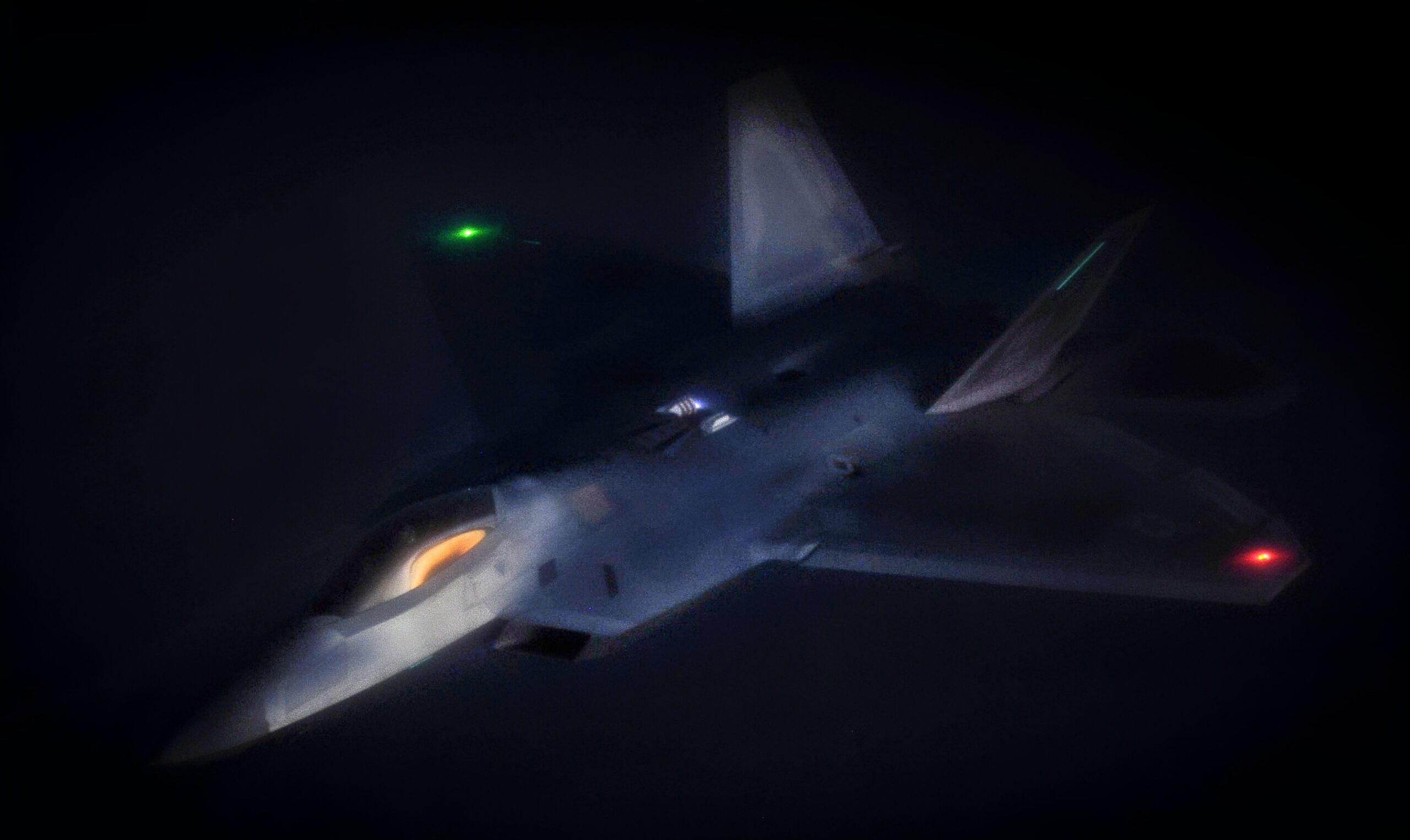
An F-22 Raptor fighter jet, assigned to the 433rd Weapons Squadron at Nellis Air Force Base, Nev., maneuvers after being refueled by a KC-135 Stratotanker during a Weapons School Integration mission over the Nevada Test and Training Range June 8, 2012. One of the most important planned aspects of this mission is holding it during the hours of darkness. (U.S. Air Force photo by Senior Airman Kevin Tanenbaum/Released)
Their doctrine is to control the battlespace by remaining unseen, making kinematic performance a secondary, albeit still important, attribute. The F-15EX and Eurofighter Typhoon occupy a middle ground, blending robust kinematics with advanced AESA radars and networking, but lacking the comprehensive stealth of their fifth-generation counterparts.
The Su-35S is thus Russia’s most potent answer to the advanced fourth-generation threat, but its effectiveness against a truly networked, fifth-generation opponent remains one of the most critical and debated questions in modern air power.
|
Aircraft |
Max Speed (Mach) |
Service Ceiling (ft) |
Thrust/Weight Ratio |
Radar Type |
Max AAM Load |
|
Su-35S |
2.25 |
59,000 |
1.13 |
PESA (Irbis-E) |
12 |
|
F-15EX |
2.5 |
60,000 |
1.29 |
AESA (APG-82) |
12 |
|
F-22A Raptor |
2.25 |
>65,000 |
>1.18 |
AESA (APG-77) |
8 |
|
Eurofighter Typhoon |
2.0+ |
65,000 |
1.15 |
AESA (Captor-E) |
10 |
Trial by Fire: Operational History and Combat Record
The Su-35S is not merely a theoretical powerhouse; it has been tested and refined through extensive combat operations in two of the 21st century’s most demanding air environments: Syria and Ukraine.
Syrian Debut (2016-Present)
The Su-35S made its combat debut in January 2016, with the deployment of four aircraft to Khmeimim Airbase in Syria. This deployment was a direct response to the November 2015 shootdown of a Russian Su-24 bomber by a Turkish F-16, signaling Russia’s intent to establish air superiority and protect its assets.
The primary missions for the Su-35S in Syria were providing top cover for Russian strike packages, conducting armed combat air patrols, and acting as a deterrent to Turkish and Israeli air operations. While they were seen carrying unguided bombs, their main role was air-to-air, and they were the first Russian fighters deployed to Syria seen carrying modern R-77-1 active radar-guided missiles.
Throughout 2019, Su-35s were frequently scrambled to intercept Israeli and Turkish aircraft. On multiple occasions, Russian and Syrian sources claimed these interceptions forced attacking aircraft to abort their missions over Syrian territory. There were also numerous close encounters with US aircraft, including anecdotal reports of simulated dogfights with F-22 Raptors. While Russian-affiliated sources claimed the Su-35S performed well, US pilots and analysts maintain that the F-22’s stealth and situational awareness provided a decisive advantage.
From a strategic perspective, the Syrian deployment was a success for Russia. It allowed the VKS to test the aircraft’s systems, particularly its avionics and engines, in a real-world combat environment, leading to software and hardware refinements.
The deployment also served as a powerful marketing tool, showcasing the aircraft’s capabilities to potential customers in the region and beyond. Russian officials reported that the Su-35S demonstrated reliability rates three to four times higher than standard, a key selling point.
The Proving Ground of Ukraine (2022-Present)
The full-scale invasion of Ukraine has provided the most intense and revealing test of the Su-35S’s capabilities and vulnerabilities. It has emerged as the VKS’s most critical air superiority platform in the conflict, adapting its tactics to a highly contested and lethal air defense environment.
The aircraft’s most significant contribution has been its role as a long-range interceptor. Flying high-altitude combat air patrols (CAPs) from the relative safety of Russian-controlled airspace, Su-35S pilots have employed the very-long-range R-37M “Axehead” air-to-air missile to devastating effect.
This tactic leverages the Su-35’s powerful Irbis-E radar to detect Ukrainian aircraft at extreme distances, allowing the Mach 6 R-37M to engage them long before they can get within range to fire their own weapons. This has posed a severe threat to the Ukrainian Air Force, which has struggled to counter these standoff attacks.
However, the Su-35S has not been invulnerable. While initial claims of losses were high, open-source intelligence has confirmed the destruction of at least eight Su-35S jets by mid-2025.
These losses have been attributed primarily to sophisticated Western-supplied ground-based air defense systems (GBADS), particularly the MIM-104 Patriot. In at least one instance, a Su-35S was downed deep inside Russian territory, highlighting the reach and effectiveness of Ukraine’s evolving air defense network.
There have also been credible reports of losses due to friendly fire, a persistent problem for Russian forces in the conflict.
The performance of the Su-35S in Ukraine presents a nuanced and complex picture of modern air combat. On one hand, its successful employment of the R-37M missile demonstrates a potent tactical adaptation by the VKS to a high-threat environment. By avoiding direct penetration of heavily defended airspace and leveraging its powerful sensors and long-range weapons, the Su-35S has established itself as Russia’s most effective air-to-air asset in the war.
On the other hand, its confirmed losses to advanced SAMs like the Patriot underscore the profound vulnerability of even highly advanced, non-stealthy 4++ generation fighters in the face of a modern, layered Integrated Air Defense System (IADS).
The war in Ukraine is thus a live-fire demonstration of the relentless competition between advanced combat aircraft and the systems designed to destroy them, proving that while the Su-35S may be dominant against other aircraft in its preferred engagement envelope, it cannot guarantee its own survival against a capable and adaptive ground-based threat.
Strategic Calculus: Doctrine, Exports, and the Future
The Su-35S is more than just a collection of advanced systems; it is a strategic instrument that reflects Russia’s military doctrine, its geopolitical ambitions, and its place in the global arms market. Its future, and that of the VKS, is intrinsically linked to the progress of the Su-57 program and the shifting dynamics of international relations.
The Flanker’s Place in Russian Doctrine
Within the Russian Aerospace Forces, the Su-35S serves as the premier air superiority workhorse, a role it is expected to hold until the fifth-generation Su-57 becomes available in operationally significant numbers.
The VKS employs a mixed-fleet strategy, where Su-35S fighters often provide air cover and escort for Su-34 strike bombers and Su-25 ground-attack aircraft.
Furthermore, it has been tested in advanced command-and-control roles, networking with the Su-57 to share sensor data in experimental “swarm” teaming exercises.
This doctrinal approach emphasizes kinetic engagement and supermaneuverability, a philosophy that prioritizes winning a direct confrontation through superior flight performance, which stands in contrast to the Western focus on stealth, data fusion, and network-centric warfare.
The Geopolitics of Export
The export history of the Su-35S serves as a clear barometer of the ongoing great power competition between the United States and Russia.
- China: The People’s Liberation Army Air Force (PLAAF) became the first export customer, signing a contract for 24 aircraft. This deal was a significant indicator of deepening Sino-Russian strategic ties and subsequently triggered U.S. sanctions against China’s Equipment Development Department under the Countering America’s Adversaries Through Sanctions Act (CAATSA).
- Egypt, Algeria, and Iran: A more complex saga unfolded with a batch of over 20 Su-35s originally built for Egypt under a 2018 contract. Cairo’s interest was driven by a need to counter regional rivals and by frustration over long-standing U.S. restrictions on the sale of advanced F-15s and long-range missiles. However, under intense pressure from Washington and the explicit threat of CAATSA sanctions, Egypt ultimately cancelled the deal. This left Russia with a number of “white tail” airframes already produced. These aircraft became a geopolitical tool. In early 2025, satellite imagery confirmed that some of these jets, still in their Egyptian desert camouflage, had been delivered to Algeria, a nation with a long history of purchasing Russian arms and less susceptibility to U.S. pressure. Iran has also reportedly finalized a deal for some of these aircraft, spurred by its provision of drones to Russia for the war in Ukraine, though actual deliveries have been repeatedly delayed, likely due to the complex geopolitical and logistical landscape.
The journey of these specific airframes—from an assembly line in Komsomolsk-on-Amur, to a failed deal with a U.S. partner, to their eventual redirection to non-aligned or adversarial nations—perfectly illustrates the Su-35’s role as more than just military hardware. Its sales and transfers act as a tangible measure of a nation’s geopolitical alignment, its willingness to defy U.S. foreign policy, and Russia’s use of arms exports to solidify influence and generate revenue in a world increasingly defined by sanctions and strategic competition.
Conclusion: The Last of the Super Flankers
The Sukhoi Su-35S is, without question, the most capable and lethal conventional fighter ever derived from the legendary Flanker lineage. It stands as a testament to the fundamental excellence and adaptability of the original Su-27 airframe, pushed to the absolute limits of fourth-generation technology.
In terms of raw kinematic performance, it remains a formidable threat to any contemporary fourth-generation aircraft in the world.
However, its long-term strategic relevance is challenged by the inexorable global shift towards fifth-generation capabilities defined by all-aspect stealth, advanced networking, and sophisticated sensor fusion.
Its combat record in Ukraine is a double-edged sword: it has demonstrated devastating long-range kill potential with the R-37M missile but has also proven vulnerable to modern, integrated air defense systems. This highlights the growing difficulty for non-stealthy platforms to survive on a transparent, high-threat battlefield.
The Su-35S will likely remain the backbone of the VKS’s tactical aviation for at least another decade, a powerful and versatile asset that bridges the gap to a future dominated by the Su-57 and, perhaps, uncrewed platforms.
Its ultimate legacy, however, will likely be that of the ultimate “Super Flanker”—the final and most potent expression of a legendary fourth-generation design, perfected at the very moment the paradigm of air combat was shifting decisively toward stealth.
About the Author: Harry J. Kazianis
Harry J. Kazianis (@Grecianformula) is a national security expert based in Orlando, Florida. Kazianis was Senior Director of National Security Affairs at the Center for the National Interest (CFTNI), a foreign policy think tank founded by Richard Nixon based in Washington, DC. He also served as Executive Editor of its publishing arm, The National Interest. Harry has over a decade of experience in think tanks and national security publishing. His ideas have been published in the NY Times, Washington Post, Wall Street Journal, CNN, and many other outlets worldwide. He has held positions at CSIS, the Heritage Foundation, the University of Nottingham, and several other institutions related to national security research and studies.
